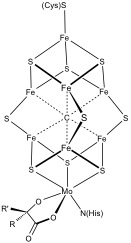Iron-sulfur protein
Iron-sulfur proteins are a class of proteins characterized by the presence of iron-sulfur clusters, which are non-heme iron sites coordinated by sulfur atoms. These clusters play a crucial role in various biological processes, including electron transfer, enzyme catalysis, and the regulation of gene expression. Iron-sulfur proteins are ubiquitous in nature, found across all domains of life: bacteria, archaea, and eukaryotes.
Structure and Function[edit | edit source]
The iron-sulfur clusters within these proteins can vary in their composition and complexity, ranging from simple 2Fe-2S and 4Fe-4S clusters to more complex varieties. The clusters are typically bound to the protein by cysteine residues, although in some cases, non-cysteine residues such as histidine may also participate in ligand binding. These clusters facilitate the transfer of electrons by alternating between different oxidation states of iron, making iron-sulfur proteins essential components of cellular respiration and photosynthesis pathways.
Types of Iron-Sulfur Proteins[edit | edit source]
There are several types of iron-sulfur proteins, each with distinct functions:
- Ferredoxins: These are small proteins that mediate electron transfer in a variety of metabolic reactions.
- Nitrogenase: This enzyme complex is responsible for the fixation of atmospheric nitrogen into a form that can be utilized by plants.
- Hydrogenase: These enzymes play a role in the metabolism of hydrogen gas.
- Aconitase: A key enzyme in the citric acid cycle, which is essential for energy production in cells.
Biological Significance[edit | edit source]
Iron-sulfur proteins are vital for the survival of cells and organisms. They are involved in the synthesis of DNA, repair processes, and the regulation of metabolism. Their dysfunction can lead to a variety of diseases, including certain types of neurodegenerative diseases and cancer. Understanding the structure and function of these proteins is crucial for the development of therapeutic strategies against these conditions.
Evolutionary Perspective[edit | edit source]
The widespread distribution and diversity of iron-sulfur proteins across all forms of life suggest an ancient origin. These proteins are thought to have played a pivotal role in the early evolution of life, particularly in the development of metabolic pathways that enabled the utilization of inorganic and organic compounds for energy.
Research and Applications[edit | edit source]
Research on iron-sulfur proteins has significant implications in various fields, including biochemistry, molecular biology, and biotechnology. For instance, engineering of iron-sulfur proteins has potential applications in the development of biofuels, biosensors, and in the bioremediation of pollutants.
Challenges in Study[edit | edit source]
Studying iron-sulfur proteins poses several challenges, primarily due to their sensitivity to oxygen, which can lead to the degradation of the iron-sulfur clusters. Advanced techniques in protein purification and spectroscopy are often required to characterize these proteins and elucidate their mechanisms of action.
Navigation: Wellness - Encyclopedia - Health topics - Disease Index - Drugs - World Directory - Gray's Anatomy - Keto diet - Recipes
Search WikiMD
Ad.Tired of being Overweight? Try W8MD's physician weight loss program.
Semaglutide (Ozempic / Wegovy and Tirzepatide (Mounjaro) available.
Advertise on WikiMD
WikiMD is not a substitute for professional medical advice. See full disclaimer.
Credits:Most images are courtesy of Wikimedia commons, and templates Wikipedia, licensed under CC BY SA or similar.
Contributors: Prab R. Tumpati, MD





